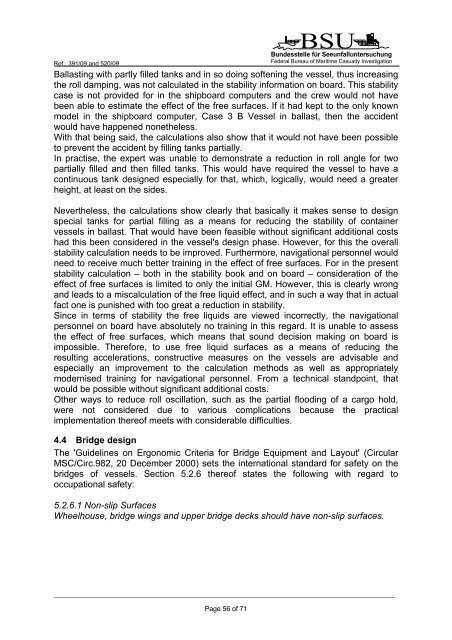SUB-COMMITTEE ON STABILITY AND LOAD LINES AND ON ...
SUB-COMMITTEE ON STABILITY AND LOAD LINES AND ON ...
SUB-COMMITTEE ON STABILITY AND LOAD LINES AND ON ...
Create successful ePaper yourself
Turn your PDF publications into a flip-book with our unique Google optimized e-Paper software.
Ref.: 391/09 and 520/09<br />
BSU<br />
Bundesstelle für Seeunfalluntersuchung<br />
Federal Bureau of Maritime Casualty Investigation<br />
Ballasting with partly filled tanks and in so doing softening the vessel, thus increasing<br />
the roll damping, was not calculated in the stability information on board. This stability<br />
case is not provided for in the shipboard computers and the crew would not have<br />
been able to estimate the effect of the free surfaces. If it had kept to the only known<br />
model in the shipboard computer, Case 3 B Vessel in ballast, then the accident<br />
would have happened nonetheless.<br />
With that being said, the calculations also show that it would not have been possible<br />
to prevent the accident by filling tanks partially.<br />
In practise, the expert was unable to demonstrate a reduction in roll angle for two<br />
partially filled and then filled tanks. This would have required the vessel to have a<br />
continuous tank designed especially for that, which, logically, would need a greater<br />
height, at least on the sides.<br />
Nevertheless, the calculations show clearly that basically it makes sense to design<br />
special tanks for partial filling as a means for reducing the stability of container<br />
vessels in ballast. That would have been feasible without significant additional costs<br />
had this been considered in the vessel's design phase. However, for this the overall<br />
stability calculation needs to be improved. Furthermore, navigational personnel would<br />
need to receive much better training in the effect of free surfaces. For in the present<br />
stability calculation – both in the stability book and on board – consideration of the<br />
effect of free surfaces is limited to only the initial GM. However, this is clearly wrong<br />
and leads to a miscalculation of the free liquid effect, and in such a way that in actual<br />
fact one is punished with too great a reduction in stability.<br />
Since in terms of stability the free liquids are viewed incorrectly, the navigational<br />
personnel on board have absolutely no training in this regard. It is unable to assess<br />
the effect of free surfaces, which means that sound decision making on board is<br />
impossible. Therefore, to use free liquid surfaces as a means of reducing the<br />
resulting accelerations, constructive measures on the vessels are advisable and<br />
especially an improvement to the calculation methods as well as appropriately<br />
modernised training for navigational personnel. From a technical standpoint, that<br />
would be possible without significant additional costs.<br />
Other ways to reduce roll oscillation, such as the partial flooding of a cargo hold,<br />
were not considered due to various complications because the practical<br />
implementation thereof meets with considerable difficulties.<br />
4.4 Bridge design<br />
The 'Guidelines on Ergonomic Criteria for Bridge Equipment and Layout' (Circular<br />
MSC/Circ.982, 20 December 2000) sets the international standard for safety on the<br />
bridges of vessels. Section 5.2.6 thereof states the following with regard to<br />
occupational safety:<br />
5.2.6.1 Non-slip Surfaces<br />
Wheelhouse, bridge wings and upper bridge decks should have non-slip surfaces.<br />
_____________________________________________________________________________________________________<br />
Page 56 of 71
















